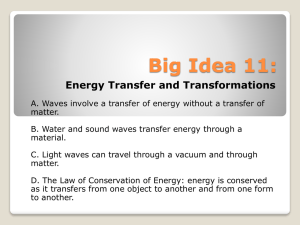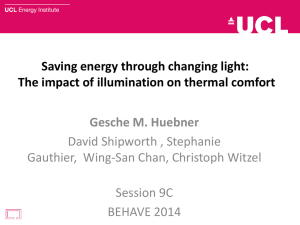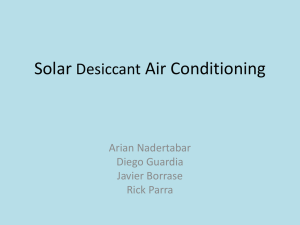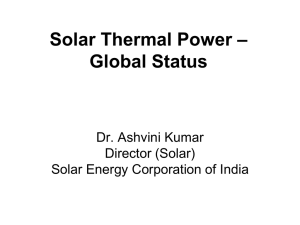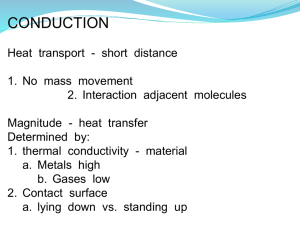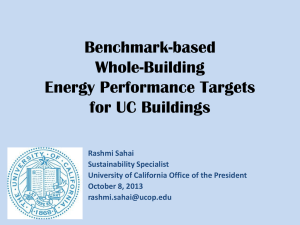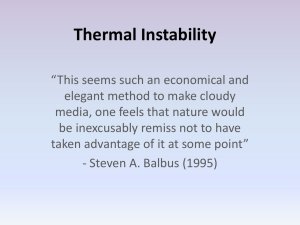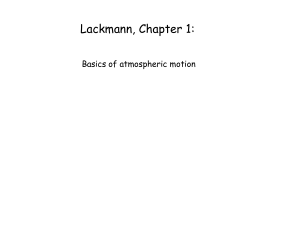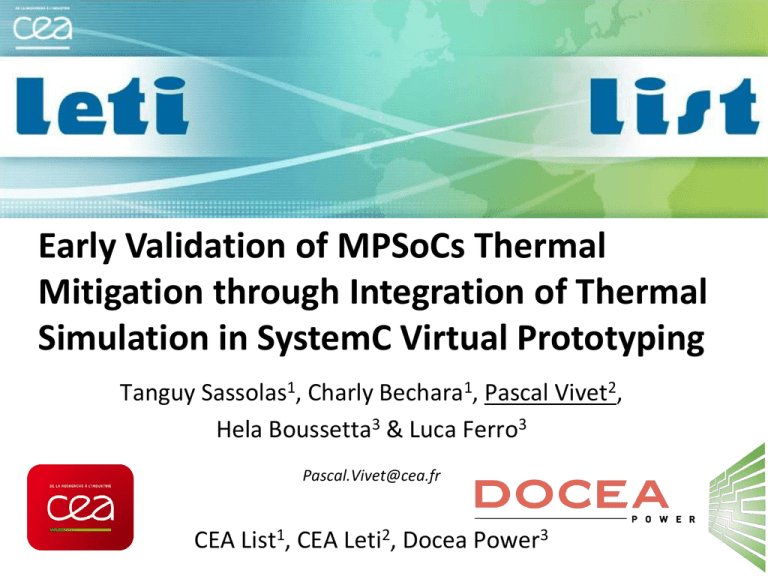
Early Validation of MPSoCs Thermal
Mitigation through Integration of Thermal
Simulation in SystemC Virtual Prototyping
Tanguy Sassolas1, Charly Bechara1, Pascal Vivet2,
Hela Boussetta3 & Luca Ferro3
Pascal.Vivet@cea.fr
CEA List1, CEA Leti2, Docea Power3
Thermal issues in modern SoCs
Increasing thermal issues
Technology scaling => higher power density
3D stacking with TSV => greater thermal issues
Temperature impacts
Power consumption
Peak performance
Ageing
Package costs
MPSoC architectures
Dynamic applications, variable execution time
Power management solutions (DVFS), can even worsen thermal properties!
Thermal mitigation schemes must be proposed at design time
Pascal Vivet| DAC’2013| June 2013
© CEA. All rights reserved
|2
Thermal design flow
12 -24 months
2-3 months
6 months
High level
model (e.g.
systemC)
New
architecture
concept
RTL
model
Architecture
exploration
VHDL
design
Area & power
consumption
netlist
Synthesis
Refined
Power Studies
Fixed
floorplan
constraints
Floorplan
exploration
chip
sales
Tape out
Place & Route
w. Thermal sign off
Fab
Circuit
test
Development & Validation
Online thermal control
Early power evaluation
Need for thermal evaluation tools that take into account a
complete SoC environment and its dynamic behaviour
Need early HW/SW thermal effects evaluation => ESL
Linking thermal/power/functional tools in the same design flow is mandatory
Pascal Vivet| DAC’2013| June 2013
© CEA. All rights reserved
|3
Thermal Simulation State of the art
Low level tools: Multiphysics simulation
Multiphysics level : FloTherm (Mentor Graphics), Icepak (Ansys/Apache), …
Mostly oriented to package/board and active cooling (fan) design
Post-layout level : Heatwave (Gradient DA)
Adapted to short term analysis at die level but long simulation times
Fine grain but not adapted to SoC/Platform level exploration
High level tools:
HotSpot: Complex grid, long transient simulation
3D-ICE: Built for 3D stacks, little packaging description
Mostly academic tools
No native evaluation of thermal impact on power nor link with VP
Existing Virtual Platforms (SystemC/TLM)
May include power models but no thermal models
No Thermal/Power/Functional ESL framework for early design
Pascal Vivet| DAC’2013| June 2013
© CEA. All rights reserved
|4
ESL Modeling & Simulation Framework
Power
AceplorerTM
Thermal
(Power modeling and coupled
Power/Thermal simulation)
Functional
AceTLMConnectTM
(Library for functional, power,
thermal parameter monitoring
& providing co-simulation link)
AceThermalModelerTM
(Dynamic Compact Thermal Model)
/ TLM
Pascal Vivet| DAC’2013| June 2013
© CEA. All rights reserved
|5
MPSoC use case: LOCOMOTIV
LOCOMOTIV architecture
Multi-Core with shared memory
Thermal sensors
Power management
Local: adapts to process/ageing/temperature
Global: DVFS control per core
Hardware Assisted Runtime Software (HARS)
Pedestrian Detection Application
Variable execution time
Parallel execution
Pascal Vivet| DAC’2013| June 2013
© CEA. All rights reserved
|6
Power & Thermal Aware Virtual Platform
Existing Virtual Platform
Application
Application
Runtime
Runtime sync
Hardware
dependent SW
Timed HW
platform or
PVT platform
Power
Power actuator
Sync HAL
ISS & HW blocks
DVFS HAL
Power unit
Thermal
Thermal management
Thermal sensor HAL
Thermal sensor
AceTLMConnect
Power & thermal
analysis tools
activity
Clock domain &
voltage supply
Static & Dynamic
power
Temperature
Pascal Vivet| DAC’2013| June 2013
© CEA. All rights reserved
|7
LOCOMOTIV : Power Modeling
Aceplorer power model
5 DPM modes (Idle 0, Idle 1, Idle 2, Idle 3, NoFetch)
5 frequencies (500 Mhz, 375 Mhz, 187.5Mhz, 68.75Mhz, 0Mhz)
1 generic frequency mode (Vdd-Hopping)
DVFS modes
DPM modes
Vdd hopping mode
Power values refined from post layout simulations
Full temperature impact is characterized
Impact on leakage
Impact on dynamic consumption
Pascal Vivet| DAC’2013| June 2013
© CEA. All rights reserved
|8
LOCOMOTIV : Thermal Modeling
Thermal description with AceThermalModeler
Model geometries and material properties
Generate a Compact Thermal model
Die model according to floorplan
SBGA304 package (5.08x5.08 mm)
PCB model (4 dies, 1 FPGA)
Thermal sensors
Real Thermal Sensor built of Ring Oscillators
Sensor temperature provided by Aceplorer
Thermal values accessed through runtime HAL
[L. Vincent, DAC’12]
Pascal Vivet| DAC’2013| June 2013
© CEA. All rights reserved
|9
Online thermal management
Software stack enhanced with thermal control
Cooperative runtime (Threads queue handed by master core)
Schedule power hungry tasks to low temperature cores
Reactive thermal control: Adapt DVFS to meet thermal budget
Profit from data dependant computation to reduce PE performances
Slack Reclamation + Idle mode when reaching temperature threshold
Slack Reclamation with Temperature Thresholds :
• If t > WCET & Temp < Thigh, then DVFS +
• If t < WCET,
then DVFS • If t > Tframe, then loose next frame
• If Temp > Tcrit., go to IDLE mode
• If Temp < Tlow, start next frame
Pascal Vivet| DAC’2013| June 2013
© CEA. All rights reserved
| 10
Thermal management results (1/3)
No thermal mitigation
Fast Simulation of Temperature
Warm-up phase (Simulators are decoupled)
Thermal budget is crossed : T > 95 °C
Peak temperature = 114°C
Thermal control is needed
Tools are mandatory for early exploration and validation
Pascal Vivet| DAC’2013| June 2013
© CEA. All rights reserved
| 11
Thermal management results (2/3)
No thermal mitigation
Idle Time Management + Thresholds
Thermal budget is respected : T < 95°C
Using thresholds : 70°C < T < 90 °C
Peak temperature = 90,71°C
Thermal control works but with poor application results :
Skipped frames : 10/52
but successive frames !
Pascal Vivet| DAC’2013| June 2013
© CEA. All rights reserved
| 12
Thermal management results (3/3)
No thermal mitigation
Idle Time Management + Thresholds
Slack Reclamation
+ Thresholds
Slack reclamation
Fine grain power and thermal analysis simulation time: 16 minutes
(SystemC VP simulation time only : 5 minutes)
Compliant with early design phases!
Thermal budget respected : T < 95°C, same thresholds : 70°C < T < 90 °C
Peak temperature = 91,2°C
Slack reclamation : use estimated remaining time to reduce DVFS
Skipped frames : 3/52. Application rendering is preserved.
Pascal Vivet| DAC’2013| June 2013
© CEA. All rights reserved
| 13
Conclusion
Validated thermal mitigation algorithm
Thermal mitigation is becoming mandatory with power & thermal issues
Thermal/Power/Functional ESL design flow demonstrated
with a MPSoC architecture on a real video application
Limited development costs
Power & Thermal modelling : using commercial ESL tools (Aceplorer & ATM)
Can be easily connected to standard Virtual Platforms (SystemC/TLM)
Limited simulation costs, using compact transient thermal models
Perspectives
More advanced (predictive)
thermal mitigation algorithm
Confrontation of the design flow
with LOCOMOTIV silicon results
Pascal Vivet| DAC’2013| June 2013
© CEA. All rights reserved
| 14
Thank you for your attention. Any Questions ???
Come and Discuss around the poster
Come and See the demo @ DOCEA’s booth,
exhibitor 2113
Pascal Vivet| DAC’2013| June 2013
© CEA. All rights reserved
| 15


